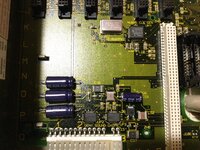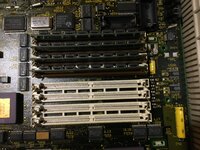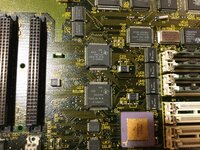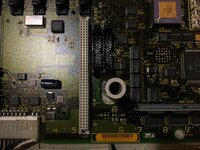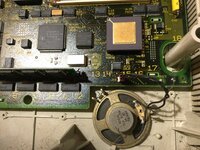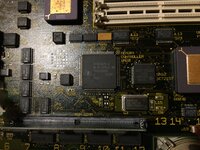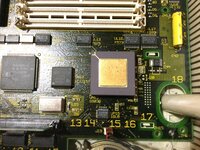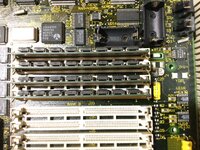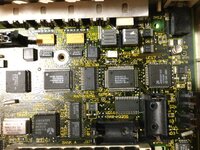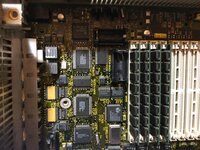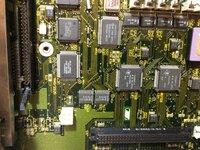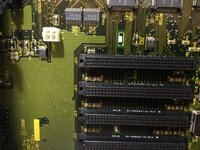Hey everyone. Been a reader here for a while. I want to get a "second set of eyes" so to speak on my issue as I've basically run out of ideas. I think I posted here about this right after it happened, but for some reason I couldn't find either my account or my old thread and had to sign up again.
Over 20 years ago, around the turn of the century, I acquired a truckload of Macs and Apples (35-45) from the University of Washington when they were "cleaning house" and purging a bunch of old machines. I knew the guy that worked there that was responsible for their disposal. I acquired this literal truckload for $20.
I repaired and flipped the vast majority of them in the intervening years, keeping only the most interesting and best units. 23 years on, I probably only have about 10, but I only keep 3-6 in use/set up at any given time.
One is a IIfx that has always been a workhorse for me. I modified the internals years ago to support 2 internal hard drives in tandem with the 2 1.4MB floppy drives at the expense of blocking a few NuBus slots. That was in 2005 and the configuration of the machine hasn't changed since.
One drive boots to A/UX and one to MacOS System 8.1. About a year and a half ago, while I was using the machine, the screen corrupted in front of my eyes and the unit froze: the bottom half of the display became static, the top half became the entire display compressed vertically into that space and only in green-scale. I reboot, and got a death chime. That was the last time the machine boot, and I'm out of ideas.
Here's what I've tried in those 18 months, that I can remember offhand at this moment:
* originally 32MB of RAM installed in 8 4MB modules, replaced with 1MB of ram in 256k modules I bought since to troubleshoot, and also all other configurations I could think of with this set of sticks
* removed the hard drives
* removed the floppy drives
* originally had an Ethernet card and a Radius video card, removed both
* tried booting without any drives or cards
* tried booting with known good drives pulled from an SE, SE/30, and Classic II respectively
* tried the above plus a video card
* tried booting with all the other NuBus video cards (known-good) that I own, which includes three Apple cards plus the Radius
* replaced the batteries 6 times over
* bought three ROMinator ROMs and tried each of those, as well as the ROM from my SE/30
* gave the MB a thorough alcohol bath (more on this later)
* obtained a brand NOS power supply and tried it
* tried the jump-start method of booting the machine vs the button
* tried pushing and pulling the RAM/ROM in various configurations while trying to boot
* put a terminator on the external SCSI port
* put an external HD with a terminator on the external SCSI port
In every scenario, the machine death chimes. The only things that varied when it death chimed or changed the chime:
* some of the Apple video cards chimed after the gray display popped up, before any disk icon, others chimed on a black screen before anything. The Radius card gets as far as the gray display with the Radius logo in the lower left, then death chimes
* the duration of time between the startup bong and death chime is directly proportional to the amount of RAM installed, the delay is longer with more, so I only assume it's failing at some point after the RAM check
* IIRC, the death chime was different with the SE/30 ROM, which I don't think is compatible anyway but it was before I bought the ROMinators
* death chime is different with invalid configurations of RAM installed (ie, 4MB/256k/4MB/256k etc), again leading me to believe the failure is after the RAM check
* also, there is no scenario in the Dead Mac Scrolls that describes what I am seeing
The logic board is and always has been immaculate. It's a late-run board that only has two electrolytics: C9 and C24, the rest are tantalums. I know C9 is part of the powerup circuit, which still works, so shouldn't be an issue. I haven't been able to determine what circuit C24 is part of, but it appears to have something to do with the RTC. I haven't re-capped either of these, but neither one seems like it could be the cause of a live-before-my-eyes crash and later death chime. As mentioned above, I am experienced at re-capping old Mac boards tens of times over. Either way, the board has been bathed in isopropyl so even if there was leakage from either of these it should have been nullified. I plan to re-cap these out of desperation despite the fact neither one seems like it could possibly be my issue but I wanted to reach out and see if anyone has any other ideas.
I'm heavily leaning towards an IC that randomly and spontaneously failed, but I have never done any kind of IC replacement on these, and wouldn't even know where to start looking, or how. That's always been above my pay grade.
Appreciate any ideas.
Over 20 years ago, around the turn of the century, I acquired a truckload of Macs and Apples (35-45) from the University of Washington when they were "cleaning house" and purging a bunch of old machines. I knew the guy that worked there that was responsible for their disposal. I acquired this literal truckload for $20.
I repaired and flipped the vast majority of them in the intervening years, keeping only the most interesting and best units. 23 years on, I probably only have about 10, but I only keep 3-6 in use/set up at any given time.
One is a IIfx that has always been a workhorse for me. I modified the internals years ago to support 2 internal hard drives in tandem with the 2 1.4MB floppy drives at the expense of blocking a few NuBus slots. That was in 2005 and the configuration of the machine hasn't changed since.
One drive boots to A/UX and one to MacOS System 8.1. About a year and a half ago, while I was using the machine, the screen corrupted in front of my eyes and the unit froze: the bottom half of the display became static, the top half became the entire display compressed vertically into that space and only in green-scale. I reboot, and got a death chime. That was the last time the machine boot, and I'm out of ideas.
Here's what I've tried in those 18 months, that I can remember offhand at this moment:
* originally 32MB of RAM installed in 8 4MB modules, replaced with 1MB of ram in 256k modules I bought since to troubleshoot, and also all other configurations I could think of with this set of sticks
* removed the hard drives
* removed the floppy drives
* originally had an Ethernet card and a Radius video card, removed both
* tried booting without any drives or cards
* tried booting with known good drives pulled from an SE, SE/30, and Classic II respectively
* tried the above plus a video card
* tried booting with all the other NuBus video cards (known-good) that I own, which includes three Apple cards plus the Radius
* replaced the batteries 6 times over
* bought three ROMinator ROMs and tried each of those, as well as the ROM from my SE/30
* gave the MB a thorough alcohol bath (more on this later)
* obtained a brand NOS power supply and tried it
* tried the jump-start method of booting the machine vs the button
* tried pushing and pulling the RAM/ROM in various configurations while trying to boot
* put a terminator on the external SCSI port
* put an external HD with a terminator on the external SCSI port
In every scenario, the machine death chimes. The only things that varied when it death chimed or changed the chime:
* some of the Apple video cards chimed after the gray display popped up, before any disk icon, others chimed on a black screen before anything. The Radius card gets as far as the gray display with the Radius logo in the lower left, then death chimes
* the duration of time between the startup bong and death chime is directly proportional to the amount of RAM installed, the delay is longer with more, so I only assume it's failing at some point after the RAM check
* IIRC, the death chime was different with the SE/30 ROM, which I don't think is compatible anyway but it was before I bought the ROMinators
* death chime is different with invalid configurations of RAM installed (ie, 4MB/256k/4MB/256k etc), again leading me to believe the failure is after the RAM check
* also, there is no scenario in the Dead Mac Scrolls that describes what I am seeing
The logic board is and always has been immaculate. It's a late-run board that only has two electrolytics: C9 and C24, the rest are tantalums. I know C9 is part of the powerup circuit, which still works, so shouldn't be an issue. I haven't been able to determine what circuit C24 is part of, but it appears to have something to do with the RTC. I haven't re-capped either of these, but neither one seems like it could be the cause of a live-before-my-eyes crash and later death chime. As mentioned above, I am experienced at re-capping old Mac boards tens of times over. Either way, the board has been bathed in isopropyl so even if there was leakage from either of these it should have been nullified. I plan to re-cap these out of desperation despite the fact neither one seems like it could possibly be my issue but I wanted to reach out and see if anyone has any other ideas.
I'm heavily leaning towards an IC that randomly and spontaneously failed, but I have never done any kind of IC replacement on these, and wouldn't even know where to start looking, or how. That's always been above my pay grade.
Appreciate any ideas.

